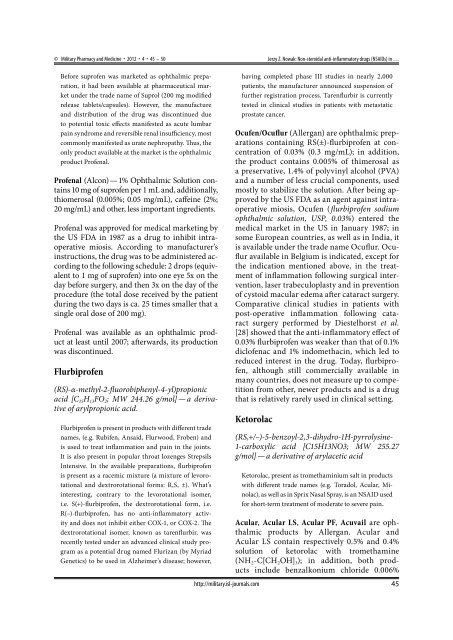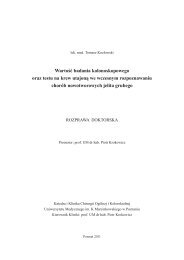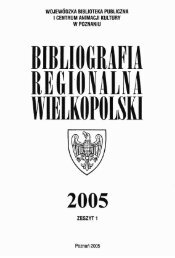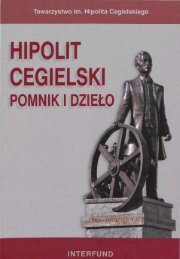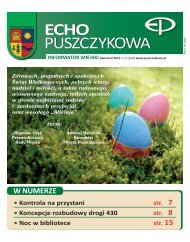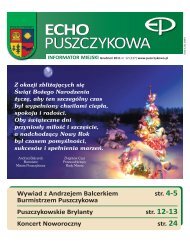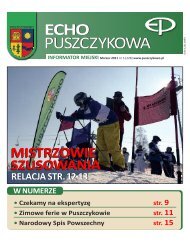MILITARY PHARMACY AND MEDICINE
MILITARY PHARMACY AND MEDICINE
MILITARY PHARMACY AND MEDICINE
Create successful ePaper yourself
Turn your PDF publications into a flip-book with our unique Google optimized e-Paper software.
© Military Pharmacy and Medicine • 2012 • 4 • 45 – 50Jerzy Z. Nowak: Non-steroidal anti-inflammatory drugs (NSAIDs) in …Before suprofen was marketed as ophthalmic preparation,it had been available at pharmaceutical marketunder the trade name of Suprol (200 mg modifiedrelease tablets/capsules). However, the manufactureand distribution of the drug was discontinued dueto potential toxic effects manifested as acute lumbarpain syndrome and reversible renal insufficiency, mostcommonly manifested as urate nephropathy. Thus, theonly product available at the market is the ophthalmicproduct Profenal.Profenal (Alcon) — 1% Ophthalmic Solution contains10 mg of suprofen per 1 mL and, additionally,thiomerosal (0.005%; 0.05 mg/mL), caffeine (2%;20 mg/mL) and other, less important ingredients.Profenal was approved for medical marketing bythe US FDA in 1987 as a drug to inhibit intraoperativemiosis. According to manufacturer’sinstructions, the drug was to be administered accordingto the following schedule: 2 drops (equivalentto 1 mg of suprofen) into one eye 5x on theday before surgery, and then 3x on the day of theprocedure (the total dose received by the patientduring the two days is ca. 25 times smaller that asingle oral dose of 200 mg).Profenal was available as an ophthalmic productat least until 2007; afterwards, its productionwas discontinued.Flurbiprofen(RS)-α-methyl-2-fluorobiphenyl-4-yl)propionicacid [C 15 H 13 FO 2 ; MW 244.26 g/mol] — a derivativeof arylpropionic acid.Flurbiprofen is present in products with different tradenames, (e.g. Rubifen, Ansaid, Flurwood, Froben) andis used to treat inflammation and pain in the joints.It is also present in popular throat lozenges StrepsilsIntensive. In the available preparations, flurbiprofenis present as a racemic mixture (a mixture of levorotationaland dextrorotational forms: R,S, ±). What’sinteresting, contrary to the levorotational isomer,i.e. S(+)-flurbiprofen, the dextrorotational form, i.e.R(–)-flurbiprofen, has no anti-inflammatory activityand does not inhibit either COX-1, or COX-2. Thedextrorotational isomer, known as tarenflurbir, wasrecently tested under an advanced clinical study programas a potential drug named Flurizan (by MyriadGenetics) to be used in Alzheimer’s disease; however,http://military.isl-journals.comhaving completed phase III studies in nearly 2,000patients, the manufacturer announced suspension offurther registration process. Tarenflurbir is currentlytested in clinical studies in patients with metastaticprostate cancer.Ocufen/Ocuflur (Allergan) are ophthalmic preparationscontaining RS(±)-flurbiprofen at concentrationof 0.03% (0.3 mg/mL); in addition,the product contains 0.005% of thimerosal asa preservative, 1.4% of polyvinyl alcohol (PVA)and a number of less crucial components, usedmostly to stabilize the solution. After being approvedby the US FDA as an agent against intraoperativemiosis, Ocufen (flurbiprofen sodiumophthalmic solution, USP, 0.03%) entered themedical market in the US in January 1987; insome European countries, as well as in India, itis available under the trade name Ocuflur. Ocufluravailable in Belgium is indicated, except forthe indication mentioned above, in the treatmentof inflammation following surgical intervention,laser trabeculoplasty and in preventionof cystoid macular edema after cataract surgery.Comparative clinical studies in patients withpost-operative inflammation following cataractsurgery performed by Diestelhorst et al.[28] showed that the anti-inflammatory effect of0.03% flurbiprofen was weaker than that of 0.1%diclofenac and 1% indomethacin, which led toreduced interest in the drug. Today, flurbiprofen,although still commercially available inmany countries, does not measure up to competitionfrom other, newer products and is a drugthat is relatively rarely used in clinical setting.Ketorolac(RS,+/–)-5-benzoyl-2,3-dihydro-1H-pyrrolysine-1-carboxylic acid [C15H13NO3; MW 255.27g/mol] — a derivative of arylacetic acidKetorolac, present as tromethaminium salt in productswith different trade names (e.g. Toradol, Acular, Minolac),as well as in Sprix Nasal Spray, is an NSAID usedfor short-term treatment of moderate to severe pain.Acular, Acular LS, Acular PF, Acuvail are ophthalmicproducts by Allergan. Acular andAcular LS contain respectively 0.5% and 0.4%solution of ketorolac with tromethamine(NH 2 -C[CH 2 OH] 3 ); in addition, both productsinclude benzalkonium chloride 0.006%45


